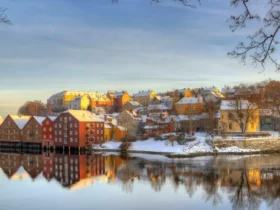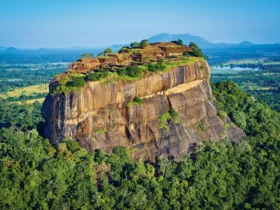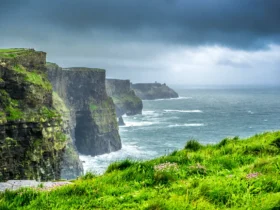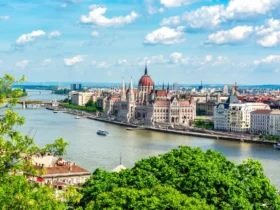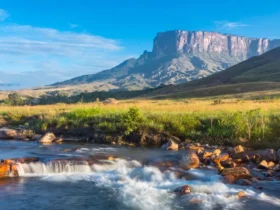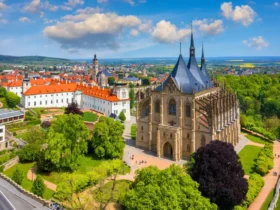Greenland is an autonomous territory located within the Kingdom of Denmark. It is the world’s largest island, located in the Arctic region between the Arctic Ocean and the North Atlantic Ocean.

Greenland offers a wealth of experiences, from exploring its natural wonders to engaging with its rich cultural heritage. Whether you’re interested in outdoor adventures, indigenous art, Arctic wildlife, or gaining insights into climate change research, Greenland provides a captivating and immersive journey. Here are some key facts about Greenland:


Geography: Greenland is geographically part of North America, although it has strong cultural and historical ties to Europe. It is mostly covered by ice and has a harsh Arctic climate. The island is known for its stunning fjords, icebergs, and vast expanses of tundra.

Population: As of my knowledge cutoff in September 2021, Greenland has a population of around 56,000 people. The majority of the population is of Greenlandic Inuit descent, and the official language is Greenlandic (Kalaallisut). Danish is also widely spoken.

Capital and Major Cities: Nuuk is the capital and largest city of Greenland. It serves as the political, cultural, and economic center of the territory. Other notable towns include Ilulissat, Sisimiut, Qaqortoq, and Kangerlussuaq.

Government: Greenland is an autonomous territory within the Kingdom of Denmark. It has its own government, the Government of Greenland, which manages most of its internal affairs. However, Denmark is responsible for defense and foreign affairs.

Economy: Greenland’s economy is primarily based on fishing, mining, and tourism. The territory has rich natural resources, including deposits of minerals such as zinc, lead, gold, diamonds, and rare earth elements. The fishing industry, particularly shrimp and halibut, is a significant contributor to the economy.

Climate Change: Greenland has been greatly affected by climate change, with rising temperatures leading to melting ice and glaciers. This has global implications, as the melting ice contributes to rising sea levels.

Culture and Traditions: Greenlandic Inuit culture is deeply rooted in the traditional way of life, including hunting, fishing, and gathering. Traditional practices, such as dog sledding, kayaking, and drum dancing, are still celebrated today. The colorful national costume, called the kalaallisut, is worn on special occasions.

Tourism: Greenland attracts visitors from around the world who are drawn to its pristine landscapes and unique Arctic experiences. Popular activities include hiking, wildlife watching, iceberg cruises, and cultural encounters with the local Inuit communities.

Greenlandic Cuisine: Greenlandic cuisine is unique and reflects the local resources and traditional practices. Visitors can savor dishes like “suaasat” (seal stew), “kiviak” (fermented sea birds), and “mattak” (whale skin and blubber). Exploring the local food scene provides a glimpse into Greenlandic culture and culinary traditions.

Northern Lights: Greenland is an excellent destination to witness the mesmerizing Northern Lights (Aurora Borealis). During the winter months, especially in northern and eastern parts of the country, you have a good chance of seeing this natural phenomenon illuminating the night sky with dancing lights.

Midnight Sun: In the summer months, particularly in the northern regions of Greenland, the phenomenon of the Midnight Sun occurs. This means that the sun remains above the horizon for 24 hours a day, creating an enchanting experience of continuous daylight. It’s a fantastic time to explore and engage in outdoor activities under the surreal glow of the sun.

Dog Sledding: Dog sledding is an integral part of Greenlandic culture and history. It has been used for transportation and hunting for centuries. Visitors can embark on dog sledding adventures, gliding across the snowy landscapes while being pulled by a team of strong and enthusiastic Greenlandic sled dogs.

Norse History: Greenland has a fascinating Norse history, dating back to the Viking Age. The Norse settlers arrived in Greenland around the 10th century and established several settlements. Ruins and artifacts from this period can still be found in various locations, providing a glimpse into the early European presence in Greenland.

Hot Springs and Geothermal Pools: Greenland is home to several natural hot springs and geothermal pools. These geothermal wonders provide a relaxing and rejuvenating experience amidst the Arctic surroundings. Soaking in warm waters while surrounded by snow-covered landscapes is a truly memorable and invigorating experience.

Arctic Wildlife: Greenland is a haven for Arctic wildlife. Besides the iconic polar bears, you can also encounter other fascinating animals such as musk oxen, reindeer, Arctic foxes, humpback whales, and a variety of seabirds. Wildlife enthusiasts can enjoy wildlife watching tours, where they have the chance to observe these magnificent creatures in their natural habitats.






Ice Sheet: The Greenland Ice Sheet is an iconic feature of the country. It covers about 80% of the island and is the second-largest ice sheet in the world, after Antarctica. The ice sheet is a vast expanse of ice, some of which is up to 3 kilometers thick. It is a unique and awe-inspiring natural phenomenon that shapes the landscapes and influences the climate of Greenland.

Ice Caving: Greenland offers the opportunity to explore mesmerizing ice caves within its glaciers. These natural formations are created by meltwater carving pathways through the ice. Ice caving tours allow visitors to venture into these enchanting blue-hued caves, marvel at the intricate ice formations, and gain a deeper understanding of glacial processes.

Arctic Hiking Trails: Greenland is a hiker’s paradise, offering a network of stunning trails across its diverse landscapes. The Arctic Circle Trail is a popular long-distance trek that spans approximately 160 kilometers, showcasing the beauty of Greenland’s backcountry. Other hiking trails, like the Kangia Trail, offer shorter but equally breathtaking experiences.

Kayaking: Greenland’s intricate coastline and fjords provide exceptional opportunities for kayaking enthusiasts. Paddling through pristine Arctic waters allows you to appreciate the serenity of the surroundings and witness wildlife up close. Greenland’s kayak culture has deep roots in Inuit traditions, and exploring the coastline by kayak provides a unique connection to the local heritage.

Traditional Hunting and Fishing: Hunting and fishing remain integral to Greenlandic culture and livelihood. Traditional hunting practices, such as seal hunting, fishing, and gathering, are important aspects of the local way of life. Engaging with the local communities and learning about their sustainable practices provides a deeper understanding of the close relationship between the Greenlandic people and their environment.


The top beautiful tourist destinations in Greenland
Greenland is a land of endless wonders, offering a unique blend of natural beauty, cultural heritage, and adventure. Exploring its icy landscapes, engaging with the local communities, and experiencing the Arctic environment firsthand will leave you with lasting memories of this remarkable destination.

Greenland offers breathtaking natural beauty and unique attractions. Here are some of the top beautiful and famous tourist destinations in Greenland:
1. Ilulissat Icefjord
Located on the west coast of Greenland, Ilulissat Icefjord is a UNESCO World Heritage site. It is renowned for its massive icebergs calving from the Sermeq Kujalleq glacier and floating out into the sea. The sight of these towering ice formations is awe-inspiring.

2. Disko Bay
Disko Bay is another captivating destination on the west coast. It is known for its picturesque landscapes, including icebergs, glaciers, and rugged coastal cliffs. The town of Ilulissat, mentioned earlier, is the gateway to exploring Disko Bay.

3. Nuuk
As the capital of Greenland, Nuuk offers a mix of urban amenities and natural beauty. Visitors can explore the National Museum of Greenland, visit the Nuuk Art Museum, and experience Inuit culture. The surrounding fjords and mountains provide opportunities for hiking and wildlife spotting.

4. South Greenland
South Greenland is known for its stunning fjords, colorful houses, and Viking history. The region offers beautiful hiking trails, hot springs, and charming settlements such as Qaqortoq and Narsaq. Qassiarsuk is a noteworthy site where Erik the Red, the Norse explorer, established the first Viking settlement in Greenland.

5. East Greenland
The remote and less-visited East Greenland is an untouched wilderness of towering mountains, glaciers, and Arctic wildlife. The dramatic landscapes, including the impressive Scoresby Sund fjord system, attract adventurous travelers and nature enthusiasts.

6. Uunartoq Hot Springs
Uunartoq is a small island located in South Greenland. It is famous for its natural hot springs, where visitors can relax in warm geothermal waters while surrounded by icy landscapes.

7. Kangerlussuaq
Situated in the western part of Greenland, Kangerlussuaq is a popular gateway for exploring the vast wilderness. It offers opportunities for hiking, wildlife viewing, and witnessing the Northern Lights during the winter months.

8. Tasiilaq
Tasiilaq is the largest town in East Greenland and provides a base for exploring the region. Its colorful houses, dramatic mountains, and proximity to the Sermilik Fjord make it a visually striking destination.

9. Qeqertarsuaq
Located on Disko Island, Qeqertarsuaq is a charming town known for its scenic surroundings. The island itself offers diverse landscapes, including basalt cliffs, hot springs, and opportunities to spot whales and seals.

10. Greenland National Park
Covering a vast area of northeastern Greenland, Greenland National Park is the world’s largest national park. It is a remote and pristine wilderness, home to a wide range of Arctic wildlife, including polar bears, musk oxen, and Arctic foxes. The park offers incredible opportunities for outdoor activities like hiking, camping, and wildlife observation.

11. Narsarsuaq
Situated in South Greenland, Narsarsuaq is a popular destination due to its fascinating history and natural wonders. It is home to the remnants of Erik the Red’s Brattahlíð settlement and the famous Norse ruins of Hvalsey Church. The area also offers hiking trails, boat trips to icebergs, and access to the nearby ice cap.

12. Qaqortoq
Qaqortoq is a picturesque town located in South Greenland. It is known for its colorful houses and flourishing arts scene. Visitors can explore the town’s sculpture park, visit the local museum, and experience the vibrant cultural events that take place here.

13. Qaanaaq
Qaanaaq is one of the northernmost settlements in Greenland, situated in the remote northwestern part of the country. It offers a unique cultural experience, allowing visitors to engage with the local Inuit communities and learn about their traditional way of life. The area is known for its stunning Arctic landscapes and opportunities for wildlife sightings.

14. Eqi Glacier
The Eqi Glacier, also known as the “Calving Glacier,” is located near Ilulissat in Disko Bay. It is known for its impressive calving events, where large chunks of ice break off and plunge into the sea, creating a powerful spectacle. Visitors can take boat tours to witness this natural phenomenon up close.

15. Qornok
Qornok is a small island located in the Nuuk Fjord system, near the capital city of Nuuk. It is known for its picturesque landscapes, including colorful houses, rugged cliffs, and abundant birdlife. Visitors can take boat tours to explore the island and enjoy the stunning coastal scenery.

16. Tasermiut Fjord
Tasermiut Fjord, located in South Greenland, is often referred to as the “Arctic Patagonia” due to its resemblance to the landscapes of Patagonia, Chile. It offers towering granite walls, glaciers, and excellent hiking and rock climbing opportunities. The fjord is a paradise for outdoor enthusiasts seeking adventure and natural beauty.

17. Thule Air Base
Located in Pituffik, Thule Air Base is a United States Air Force base situated in the far northwestern part of Greenland. While access to the base is restricted, the surrounding area is known for its Arctic wildlife, including musk oxen and polar bears. It offers a unique opportunity to experience the remote and extreme Arctic environment.

18. Prins Christian Sund
Prins Christian Sund is a narrow, 100-kilometer-long sound located in South Greenland. It is known for its majestic fjords, towering cliffs, and glaciers. Sailing through the sound provides breathtaking views of the rugged coastal landscapes, icebergs, and wildlife.

19. Sisimiut
Sisimiut is the second-largest town in Greenland, located on the west coast. It offers a mix of traditional Inuit culture and modern amenities. Visitors can explore the town’s historic buildings, enjoy outdoor activities like hiking and dog sledding, and experience the local way of life.

20. Uummannaq
Uummannaq is a small town located on a picturesque island off the northwest coast of Greenland. The town is known for its distinctive heart-shaped mountain and traditional wooden sledges. It offers opportunities for hiking, kayaking, and experiencing traditional Inuit culture.

21. Aasiaat
Aasiaat is a charming coastal town located in western Greenland. It is known for its stunning scenery, including picturesque fjords and colorful houses. The area offers opportunities for hiking, boat trips, and experiencing the local Inuit culture.

22. Upernavik
Upernavik is a small settlement located in northwestern Greenland. It is famous for its unique and colorful wooden houses perched on rocky islands. The breathtaking Arctic landscapes surrounding Upernavik make it a picturesque and peaceful destination.

23. Kulusuk
Kulusuk is a small island situated on the eastern coast of Greenland. It is known for its rugged landscapes, jagged mountains, and vibrant traditional Inuit culture. Visitors can explore the nearby Tasiilaq region, hike to scenic viewpoints, and immerse themselves in the local way of life.

24. Qeqertarsuatsiaat
Qeqertarsuatsiaat is a peaceful settlement located on an island in the Nuuk Fjord system. It is known for its serene beauty, with colorful houses lining the coast and stunning views of the surrounding mountains. It offers opportunities for hiking, kayaking, and enjoying the tranquility of the Arctic wilderness.

25. Nanortalik
Nanortalik is a picturesque town situated in southern Greenland. It is surrounded by towering mountains, fjords, and an archipelago of small islands. Nanortalik is an ideal destination for hiking, boat trips, and exploring Greenlandic history and culture.

26. Eqip Sermia Glacier
The Eqip Sermia Glacier is a magnificent glacier located near Ilulissat. It is renowned for its impressive calving events, where chunks of ice break off and create massive icebergs. Boat tours take visitors close to the glacier, offering a captivating experience of this dynamic natural wonder.

27. Narsaq
Narsaq is a town nestled in a picturesque valley in South Greenland. It offers breathtaking views of mountains, icebergs, and the surrounding fjords. Narsaq is an excellent base for exploring the area’s hiking trails, hot springs, and observing local wildlife.

28. Nuuk Icefjord
The Nuuk Icefjord, located near the capital city of Nuuk, is a stunning fjord system that showcases impressive ice formations. Visitors can take boat tours to witness the towering icebergs and glaciers, providing a memorable Arctic experience.

29. Disko Island
Disko Island, located off the west coast of Greenland, is known for its rugged beauty and unique geological formations. The island features towering basalt cliffs, stunning Arctic flora, and an abundance of wildlife. It is also a great spot for whale watching, as humpback whales are often seen in the surrounding waters.

30. Ittoqqortoormiit
Ittoqqortoormiit is a remote settlement in Northeast Greenland, characterized by its pristine Arctic landscapes and isolation. The area offers opportunities for dog sledding, wildlife watching (including polar bears), and immersing oneself in the local Inuit culture.

31. Ivittuut
Ivittuut is a former mining town located in South Greenland. It is known for its abandoned cryolite mine and the unique landscapes that have developed around it. The area now serves as a haven for birdwatching, with a large population of breeding birds residing in the surrounding wetlands.

32. Sermitsiaq
Sermitsiaq is a distinctive mountain located near Nuuk, the capital of Greenland. It offers stunning views of the surrounding fjords and is a popular hiking destination. Climbing to the summit rewards hikers with panoramic vistas of Nuuk and the surrounding landscapes.

33. Kujataa
Kujataa is a UNESCO World Heritage site located in South Greenland. It is an agricultural landscape that showcases the historical farming practices of the Norse settlers who arrived in Greenland over a thousand years ago. The area offers a unique blend of cultural heritage, Viking ruins, and beautiful natural surroundings.

34. Sermermiut
Sermermiut is an archaeological site and former settlement located near Ilulissat, a town in western Greenland. The site holds significant historical and cultural importance as it was once inhabited by Inuit people, specifically the Saqqaq, Dorset, and Thule cultures. The remains of ancient dwellings and other structures can still be seen at Sermermiut, providing insights into the lives of the indigenous people who lived there thousands of years ago.

35. Tjodhildes Church
Tjodhildes Church, also known as Thjodhild’s Church or Thjodhild’s Church Ruins, is an archaeological site located in Qassiarsuk, Greenland. It is named after Thjodhild, the wife of Erik the Red, who was an influential figure in the Norse colonization of Greenland.

36. Cape Farewell
Cape Farewell is a prominent headland located on the southern tip of Greenland. Known as “Kap Farvel” in Danish, it is situated in the Kujalleq municipality. Cape Farewell is considered the southernmost point of Greenland and is a significant landmark in the region.

These beautiful places in Greenland offer diverse landscapes, cultural experiences, and opportunities for adventure. From remote settlements and untouched wilderness to stunning mountains and unique geological formations, Greenland continues to captivate visitors with its extraordinary beauty.

These are just a few more highlights of the diverse attractions and experiences available in Greenland. The country’s untouched wilderness, rich cultural heritage, and unique Arctic environment offer travelers an extraordinary journey into a land of natural wonders. Hopefully this article helps reader for wonderful experiences!
